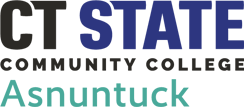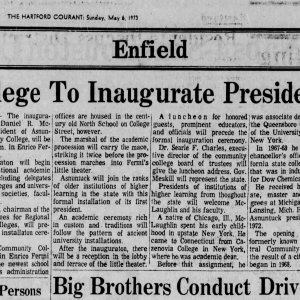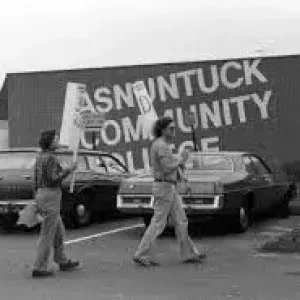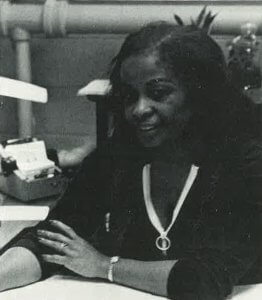50th Anniversary
 Asnuntuck Community College is celebrating its 50th anniversary this year.
Asnuntuck Community College is celebrating its 50th anniversary this year.
The college is planning events, and various ways to remember and recognize the milestone through the 2023 Commencement. Please check back often under events to see what is being planned.
Asnuntuck Community College was established in 1969 by an act of the Connecticut state legislature as the twelfth institution in the Connecticut state community college system. Classes began in 1972 with an initial enrollment of 251. 12 Associate in Science degrees and 20 Associate of Art degrees were awarded to the first graduating class in 1974. The college operated under provisional approval until it was first accredited by the New England Association of Schools and Colleges in 1977.
Since the first graduation in 1974, more than 7,844 credit graduates and non-credit certificate completers have been awarded 12,816 degrees, certificates and non-credit certificates from Asnuntuck Community College.
50th Anniversary
Save the Dates:
Dueling Pianos Music and Song for Scholarships – Friday March, 31st, 2023

23rd Annual Foundation Golf Tournament – Wednesday, October 4th, 2023

MANUFACTURING TECHNOLOGY 1997 TO PRESENT
By: FRANK D. GULLUNI, DIRECTOR EMERITUS
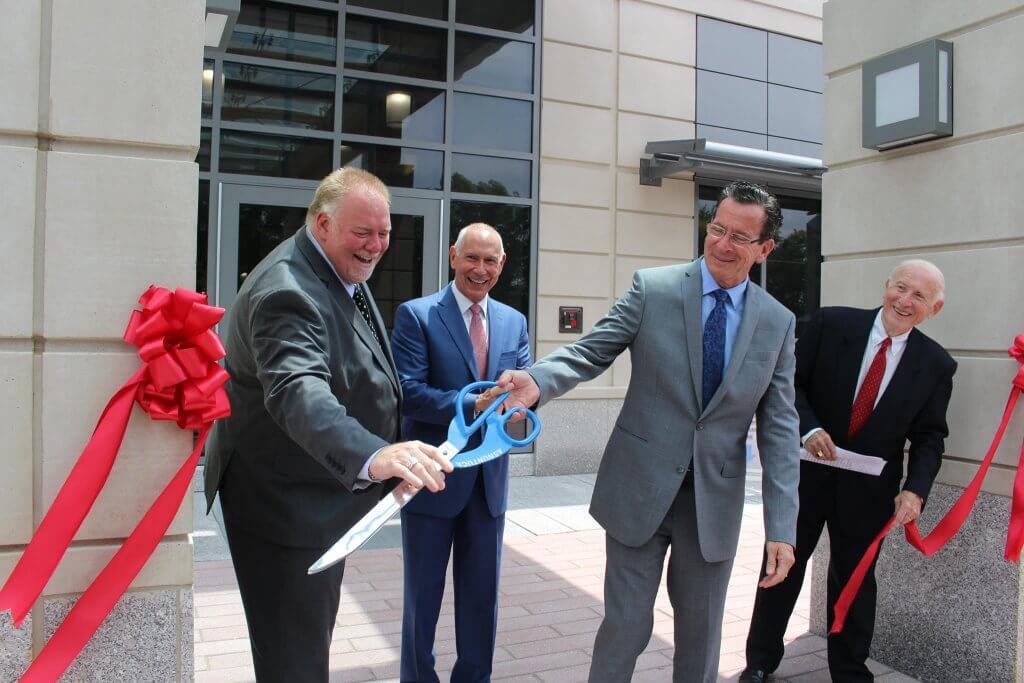
At the close of a very long career in the Western MA area, 1965-1997, I began contemplating my next adventure hoping to build on a truly incredible voyage combining education and technology training for youth and adults in need of long-term, successful careers in the private sector.
Ironically, within a few months of my retirement from the City of Springfield in the spring of 1997, I received a call from an old friend who had recently accepted the position of Economic Development Director for the town of Enfield. Ray Warren requested my services to assist in the development of a machining program designed to serve the growing, unmet needs of the area’s manufacturing industries.
In September of 1997, I agreed to work with Ray and the local manufacturing leadership, and, within a few months, we initiated a basic machining program at Asnuntuck Community College.
Between September 1997 and February 1998, I employed three critical staff: Bob Bressani, Tom Cardarella, and Paul Felici. Collectively, we were able to locate viable floor space at Asnuntuck Community College, complete the required modifications to the space, access at no cost the requisite basic and CNC machines and complementary tooling from Pratt & Whitney and other manufacturers, develop and gain state approval of curriculum, and, finally, recruit more than twenty women and men for a February start date.
Critical to our collective ability to achieve an actual start-up within 120 days of my tenure were a number of major contributors: Congresswoman Nancy Johnson who supplied us with a $500,000 federal grant; Al Samuel, with the Aerospace Components Manufacturers, who assured the support and commitment of a consortium of employers representing more than 120 companies; and Harvey Irlen, President of Asnuntuck Community College, who believed from the onset and supported fully our plan to establish a successful manufacturing technology education center at Asnuntuck.
As a result of Federal grants and significantly enhanced support from the manufacturing and public sector communities, the Asnuntuck program was able to serve substantially greater numbers of students, often in excess of 400 annually.
Additionally, we introduced a College Connections program soon after gaining approval from the Board of Higher Education to offer both certificate and degree programs in manufacturing technology. College Connections is a unique feeder system to full-time participation in for-credit manufacturing programs at Asnuntuck. High School juniors and seniors across the region travel to Asnuntuck and participate daily, generally for two hours, and are eligible to earn 3 to 4 college credits per semester. Upon high school graduation, a significant percentage of our College Connections participants choose to matriculate to Asnuntuck as full-time students in certificate and degree granting manufacturing programs.
It is also important to mention the relationship that unfolded over a period of years between the Asnuntuck Manufacturing Technology Center and the Connecticut Corrections system. To ensure optimal utilization of our facilities, we made the decision to enroll inmates from area prisons between 4 and 9 p.m. daily. Many of the inmates were able to complete the program before or shortly after completing their prison sentences. Most of them transitioned to meaningful, career-centered employment in the private sector community.
It is important to note also that more than half the community colleges in CT presently include manufacturing technology coursework in their mix of certificate and degree programs. Asnuntuck was the model and shared willingly its knowledge and experience with other colleges across Connecticut.
Due to major support from the manufacturing sector and with the commitment of Governor Malloy and the leadership of the community college system, Asnuntuck was awarded in 2015 a grant exceeding 20 million dollars to construct and equip a 27,000 square foot manufacturing facility on the Asnuntuck campus. The Center is state-of-the-art and includes the latest in technology mirroring very closely the manufacturing systems and processes in place currently in private sector companies across Connecticut and Western Massachusetts.
Without question, the Asnuntuck Community College Manufacturing Technology Center required vision, commitment from both the public and private sectors, and leadership ranging from elected officials like Governor Malloy and Congressional representatives, from Pratt & Whitney and Al Samuels and Paul Murphy from the Aerospace Components Manufacturers, and, most important, the support and trust demonstrated by Asnuntuck Community College presidents, Harvey Irlen, Martha McLeod, and Jim Lombella.
Finally, I wish to express my gratitude to the more than 4,000 students who participated in the myriad of manufacturing programs at Asnuntuck and to the many staff and instructors who continue to persevere daily to ensure students are prepared fully for long-term, successful careers in the manufacturing sector.
The Pioneers
On June 12, 1972, a college in Enfield was finally authorized by the Board of Trustees of CT Community Colleges. 50 years ago last September a small group of people opened North Central Community College (the original name). The President, Dan McLaughlin, had been identified the year before when the college almost opened. Typical Dan, he had left Michigan for Connecticut to get going well before he was hired. However, the college opening was cancelled and Dan ended up at Cazenovia College in upstate New York. Lucky for a couple of people, as you will read.
But, how “small a group” is “small”? How many employees? 15
15 employees to do everything necessary to create and open a college. Who were they?
Four faculty. You read that right. 4. With no Academic Dean, no academic administrators, not even an assistant. Who were the intrepid four?
1. Bob Bergquist, English and Communications, who also handled many liberal arts areas, helped design course requirements, orient new teachers to college course requirements, and more.
2. Peter Carley, History and Humanities, cover many areas in liberal arts, lead discussions on academic policies and procedures – and as the senior faculty member he assumed the role of temporary Academic Dean!
3. Elaine Folkers, Chemistry, who also covered the rest of science, and mathematics. Develop labs, negotiate with the town to use high school labs, find supplies and equipment, design curricula, as well as figure out her own courses!
4. 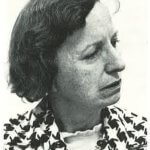 Natalia Masaitis, Secretarial Studies, who also helped with business and accounting. Nat had the advantage of having been at Northhampton Junior College, which had closed, so she was able to help with ideas about what typical colleges in the area did. Then, she and others modified those ideas of course!
Natalia Masaitis, Secretarial Studies, who also helped with business and accounting. Nat had the advantage of having been at Northhampton Junior College, which had closed, so she was able to help with ideas about what typical colleges in the area did. Then, she and others modified those ideas of course!
4 Full-time faculty members to develop degrees, determine courses, figure out a class schedule for this new college, and decide course content – including in areas they did not teach! Oh, and hire part-time faculty and acquaint them with this new community college idea!
Dean of Students, Judy Shaffer. With no counselors, Judy had to work fast to help all college staff with the basics of advising students, create student policies, design the new catalog, do a lot of advising, help with admissions, lead discussions about college goals, and …. As a young, single mom with two children, Judy knew the special problems single parents had and was attuned to the challenges many returning Vietnam vets faced, so both types of students were highlighted at this new college.
Judy was fortunate to get Iraida Gonzalez as her assistant, compliments of the President’s assistant (really the Assistant President), Mary Chiles. Mary had worked with Iraida at the Department of Community Affairs, and convinced her that she could do more for people at this new community college thing. Iraida brought practical office administration skills along with being the only Spanish-speaking staff member.
Mark Breitbart, the young Registrar, and with no one in Admissions, Mark did Admissions also! Mark had an assistant, Dottie Belanger, also compliments of Mary Chiles. Two people to handle all student records, indeed to create an entire system. On paper. With a card file with cards to write each student’s name on who registered for a course, and then number the card so as to not overload courses. Then, type up individual class rosters, and get them to teachers. Student grade reports typed out. Grades typed in one at a time for each student in each course. Transcripts done by hand. Imagine typing out a file folder for each student and hand-creating a student record.
With no one in Financial Aid, it was helpful that Dean of Administration, Roy Merolli, previously had been Assistant to the President at Middlesex CC. He helped with financial aid in addition to running the entire business office. Purchasing, billing, renting, running the building – Roy was also the de facto director of community services and non-credit programs since he had been involved in those at Middlesex.
Roy had a huge staff!
Joe Gervascio, Chief Accountant, who came with prior service with the State Auditors! While that is a great place to get an accountant from, Joe had also participated in audits of Eastern CSU, Quinebaug Valley, Middlesex and Norwalk – so he was especially valuable! Community college procedures and processes were at least something he had been exposed to! Of course. Joe also had to do a lot of non-accounting things since there was only one other person in the Business Office.
Carol Spanilo, Roy’s assistant, who brought significant practical skills and a desire to help community college students, as she understood the challenges many faced. Carol also worked with non-credit teachers, community services programs, and helped out with all administrative material!
You expected more? Nope. NO ONE in Human Resources. NO ONE in Purchasing. NO ONE in billing. NO ONE in maintenance.
All using paper. Only on paper. With calculators and typewriters. Paper files and telephones. Carbon paper if you needed a copy of something being typed.
But, heck, at least they had a library. Well, not really, but Mike Moran, Librarian, was there and even had an experienced Library Aide, Doris Cruse (also compliments of Mary Chiles who convinced HER MOTHER to leave the CT State Library to come to this new college!). Hey, two people to create a completely new library with very little money – what could be easier.
Doris had also worked for another state agency, so she could help with state bureaucracy issues. Mike’s first task was getting some books. Shelves, books need shelves. And then some more of both – with almost no money. Determining what periodicals might be useful. Finding out how the state handled purchases. Mike and Doris had to find equipment, beg, borrow and find books – and then get them on shelves. And create a card file by hand. And file library cards by hand. And try to figure out what books they might have that would help a student doing history research, or something in business – by hand and in their head.
The last two? President Dan McLaughlin, from Michigan (where Dan saw Bob Bergquist’s resume’ on a college job posting site and clearly liked what he saw!). Dan had left for Connecticut in 1971 (see the first piece in this series for the ‘on-off-on-off-on” way the college started). When the college did not open, Dan ended up at Cazenovia College in upstate New York, where he met Peter Carley and Elaine Folkers and convinced both to come to Connecticut in ’72. Dan had to hire an entire staff, build a team, find an office, figure out Connecticut’s bureaucracy (truthfully, he never did that), help mold the culture of this new college, etc, etc, etc. Fortunately for him, and everyone connected with the college, he had wonderful help in …
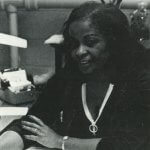 Mary Chiles, technically Assistant to the President, but everyone knew she was really Assistant President – also the personnel officer, liaison with the state bureaucracy, liaison with the Central Office, liaison with the town (she lived in Suffield), purchasing helper, finder of key employees, student recruiter, counselor, finder of space for the college, etc. See “The First Employee” for more on Mary!
Mary Chiles, technically Assistant to the President, but everyone knew she was really Assistant President – also the personnel officer, liaison with the state bureaucracy, liaison with the Central Office, liaison with the town (she lived in Suffield), purchasing helper, finder of key employees, student recruiter, counselor, finder of space for the college, etc. See “The First Employee” for more on Mary!
That’s it. 15 people designed and delivered a new college in one summer. With no computers. No word processing. No internet to gather data and compare ideas. No outside help. Oh yes, and they also had to hire a bunch of part-time faculty to teach, and orient them to college and the kinds of things that college courses covered. And find equipment and materials for both the college and classes. And space, since the “old North School” where NCCC opened had only a couple of classrooms.
All that colleges do to open a fall term, and they did it for the first time.
The First Grad
So – do you know who the first graduate was from the new community college? Was it a young student? A woman? A man?
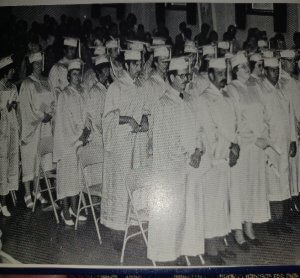 The first Asnuntuck graduate was, in many ways, emblematic of the strength of the college in its beginning years. Harry Barlow was an older student who never had a chance to get a degree when he was younger. Asnuntuck opened and Ted, as he was known to everyone, immediately took advantage of having a college right down the road. And, yes, that is Ted in the first seat.
The first Asnuntuck graduate was, in many ways, emblematic of the strength of the college in its beginning years. Harry Barlow was an older student who never had a chance to get a degree when he was younger. Asnuntuck opened and Ted, as he was known to everyone, immediately took advantage of having a college right down the road. And, yes, that is Ted in the first seat.
He was proud to be the very first person to walk across the podium, shake President McLaughlin’s hand, and get a physical Asnuntuck degree. Ted is quoted in the first yearbook – “I am glad I came; happy I did what I did.”
Ted also was quick to point out that there were not that many men in most of his classes, as most of the college’s students were older females (remember, gender roles were just expanding back then so far fewer girls in the 1940’s and 50’s, even the 60’s were encouraged to go to college). A couple of staff members from that tine remember Ted laughing as he saw the irony of being the first graduate, with so many more women receiving degrees.
A question – Ted took courses in a physical location where not many other students can say they also took courses. Where was it?
The “old North School”. Good guess. The location of the college’s administration before 1974, when the college moved to the Phoenix Avenue warehouse, did have a couple of classrooms. However, that was not the answer we were looking for as those rooms were used until the college moved.
Guess again. Here is a clue. Which Enfield High School did Ted take courses at?
Oh, you guessed Fermi High School? Well, the college did use the brand-new Fermi for a few specialized courses, but not in those early years.
But, no. The question actually was which “Enfield High School” – not which high school in Enfield.
You didn’t know that there were two “Enfield High’s”? Too bad. The old “Enfield High” is now called …. Alcorn School. Asnuntuck used classrooms at Alcorn for the first year (Enfield school system not too sure about this new community college thing so better only let them use the 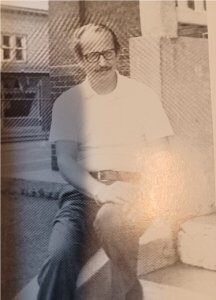 OLD Enfield High classrooms!).
OLD Enfield High classrooms!).
What else? Yes, Ted probably brought his young family to college picnics held several times during year as these were ‘family events’ designed to bring the Asnuntuck community together. It is also a good bet that they came to the Halloween Party, and the end-of-semester parties that were family events.
No, he probably did NOT bring them to the first student-staff basketball game (although his younger daughter, not even born before he graduated, was quite a basketball player growing up!).
The first student-staff softball game, held outside at Forest Park in Springfield? No one can remember, but it is possible since it was (1) outside, (2) he had 2 young children, and (3) Ted was already a strong supporter of Asnuntuck.
Ted became a cheerleader for Asnuntuck in the Enfield community, encouraging older people to return to college, advocating for more funding for community colleges, and encouraging young students to think of going to ACC for either career skills or the first two years of a four-year degree.
Not only that, he inspired his entire family to connect with the college. Wife, Dora, was heavily involved with the University of the Third Age, serving in a number of capacities in that program. Son, Joseph, took courses at Asnuntuck. Daughters, Margaret and Theresa, also came to Asnuntuck.
The Barlows. An ‘Asnuntuck First Family’ for sure.
An Art Show In Enfield?
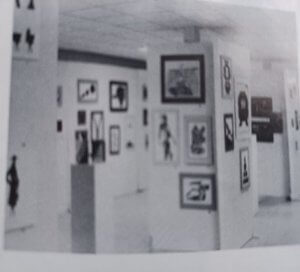 As people sip wine and munch on appetizers, student artists explain their art work. Obviously proud, many say they never thought they’d be in an art show, much less in Enfield. How did this happen?
As people sip wine and munch on appetizers, student artists explain their art work. Obviously proud, many say they never thought they’d be in an art show, much less in Enfield. How did this happen?
Let’s go back to 1975 and a discussion with the young sculptor and UCONN faculty member looking skeptical.
“Exactly why should I leave UCONN for … what’s the name of the college again?”
“Asnuntuck, in Enfield. Why? Because you come from East Hartford and Enfield has people just like your friends growing up. Because you played football to fit in and get some anger out.
Community colleges have a special mission to reach out and grab people like some of your friends. The ones no one even suggested go to college. The girls who had a couple of kids and then figured out that the guy they were with was not good – who now have not much of a future. The guys who went to Vietnam and are now home, but not home. The ones who made one mistake and now …
Some of them come to community college, and sometimes, sometimes we can reach them. And about art, the people who no one ever – EVER – encouraged to pursue their art because no one like them ever does that. Some of them walk in our door too, anxious and wondering – do I have talent? How many people like that do you see in your UCONN classes?”
Tony Cirone paused and then said, “Almost none.” 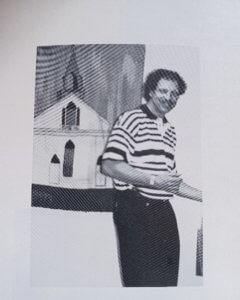
“So, I guess you have to ask yourself whether you are going to remember where you came from and who got left behind; and then decide who you are.”
Tony paused very briefly. “I want to teach art the way I want to teach it. If a student wants to take a particular course, I decide if they can skip any prerequisite. If I decide to keep the art room open at night or some other time, I decide that. And I want to put on student art shows all the time. These students deserve to be in a show. Also, my students deserve an art room that says that they are important, and that their art is important.”
At that, there was a laugh. “Ahh, this is a community college. We have an art room, but we are in a warehouse. No windows.”**
For 35 years, Tony Cirone did exactly what he wanted with the art program. His courses. His way. Opening the art room at odd hours and coming in on Saturdays to accommodate students who had no place to work. Cutting easels down for students in wheelchairs, finding special easels for students with limited arm mobility, getting his students to believe in themselves and their talent.
Tony enjoyed all of his students and promoted their art tirelessly. However, sometimes Tony found a student – someone who he helped get on a ladder that the student didn’t think would ever be there, and he’d talk about them.
He did his art shows. No, THEIR art shows. Students and the Student Senate promoted them, as did his colleagues. The college provided appetizers and drinks (even wine the first few years!). A real art show. He proudly showed off student artwork. More importantly, the first night of each show he pushed students to be physically present with their art and explain it to attendees. He wanted them to be proud, to show their work to family and friends, and to know that THEY HAD CREATED SOMETHING IMPORTANT.
When the college got funds to expand, everyone knew that Tony would get the art room he wanted, with high ceilings and windows providing indirect light. Space enough for someone to come into a class, throw him a football and then tell the students their art instructor had played semi-professional football for the Willimantic Ramblers. Another way to connect, to draw one more student out.
At the retirement party for the 2009 retirees, a participant remembers Tony being asked what he was proudest of. “Never forgetting where I came from and that I was not teaching art, I was teaching special students.”
Tony Cirone: An Asnuntuck Original
***quotes at the beginning are not exact, but do reflect the gist of the conversation.
A Look Back
How Many Courses At Once?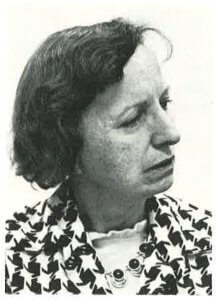
“There were students taking all different courses, at the same time. It looked like chaos, but it wasn’t. I was one of her students and she knew how to get you to what you needed to learn quickly. (Mona Piotrowski, Assistant to the President).”
Hmmm. What was going on? People looking into the Secretarial Science room in the mid-70’s would find 3 – 4 students with earphones on listening to cassette tapes in one corner and typing away (Dictation & Transcription II). Another corner would have 5 or 6 students also listening to tapes, but typing much slower (Dictation & Transcription I). Down front, Natalie might actually be teaching Typing I. And, in the middle still other students were typing rapidly from material propped on a stand next to their typewriter (Typing II and Typing III students – you could tell from the speed with which they typed).
And that was all the time in every course she taught after the first week or two of every semester.
Natalia Masaitis was one of the first five faculty members at Asnuntuck, and she believed that her mission was to help her students, mainly women, get jobs as quickly as possible. In the 1970’s there was a huge demand for office workers and Natalie intended to have her students get those decent jobs in insurance companies, banks and the defense industry.
Natalie knew from personal experience and her previous job teaching the same subject just how much many students needed jobs quickly. Go back to the 1970’s and we have a time when there were not many options open to women for work. A woman who needed a change in her life and the lives of her children if she had some, had to get a job and too-often, quickly.
Natalie thought her job was to help her students become more independent, so they could live a fuller life.
When the concept of individualizing education was very new in higher education, Natalie convinced ACC administration to invest in the individualizing tools of the time. There were some self-study guides, and some cassette tapes and Natalie got them purchased in bulk. For subjects not covered, or not covered to her satisfaction, she made tapes herself and wrote out materials.
“I remember that Natalie could not get medical dictation and transcription tapes and medical secretary jobs were often very good ones. She got me to help her make her own tapes. Often I had no idea the meaning of words I was reading onto a cassette tape (Mona Piotrowski).”
She did the same with legal dictation and transcription. The commercial tapes were too pricy for Asnuntuck, so she made her own.
Presto! Asnuntuck now offered Legal Dictation and Transcription and Medical Dictation and Transcription courses.
Class times meant little. After the first week or two of the semester, where she made assessments of a student’s abilities, she would get students onto the right path (and the “right path” was determined totally by Natalie!), and allow them to come to almost any of her classes to do their work. If they wanted in-person instruction, they came to their course at the scheduled time, as she would spend considerable time during that “class period” teaching the subject. However, she also would give assignments to complete and then help out whomever else was studying in class at the same time.
Natalie created what we’d call outcomes today for each course and allowed a student to move at their own pace toward those outcomes. If someone could do Typing I, II, and III the same semester, Natalia wanted that student to complete those 9 credits in one semester. The Registrar’s Office employed some creative record-keeping, fortunately the college had a Registrar and assistant who were adept at fixing records, as they understood how important it might be.
An added benefit to the college was that Natalie wanted her students to get ‘real-world’ experience, so recommended many for student worker jobs. With a poorly staffed college, hot-shot student workers filled huge gaps – with the benefit that they could also lend fellow students a willing and sympathetic ear.
Mornings. Evenings. Even some Saturdays. Natalie was back in “HER” room doing her best to move HER students toward a better future.
Natalia Masaitis – an Asnuntuck Original!
Bill Searle
Asnuntuck Leads Into The Video Age!
It is 1977 and Bob Bergquist, English faculty member, sees the future – and i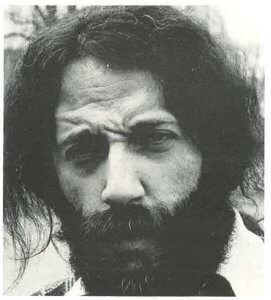 t is moving, in color, and exciting. He presses the administration to fund a television studio and develop a new degree program. A television studio? 1977? $2,000,000? And a number of highly trained (and PAID) staff.
t is moving, in color, and exciting. He presses the administration to fund a television studio and develop a new degree program. A television studio? 1977? $2,000,000? And a number of highly trained (and PAID) staff.
Bergquist suggests something new – how about using a new technology, 3/4” videocassette tape! Bob thought that a studio could be put together for under $500,000, and manned by students under the direction of one professional.
If realized, this would be the first production television studio in any Connecticut community college. But, still, where to get the money?
At the same time, across the country more and more women are developing careers, wanting to move full-time into the workforce. But there is a problem. Many have children they are the primary care-giver for.
There are nowhere near enough day care centers to fill the need, and those that exist are often make-shift, with staff training almost non-existent. The students working in the college’s Reading Room strongly supported ‘doing something’.
The two ideas came together and college staff approached the state Title XX office that managed state day care at the time. How about developing a library of video tapes on early childhood topics, and run a lending library for the whole state, with professional early childhood educators making the rounds to show how to set up the new videocassette players, introduce tapes, and teach?
The proposal was accepted and Asnuntuck received $500,000 for video equipment and materials, along with funding for four day care trainers (much to the chagrin of several other community colleges with early childhood degree programs, which had submitted day care training grants without the video component).
The technology worked! Berquist recruited students and they quickly got excited with what they could do. Word quickly spread to students from surrounding colleges, who came to Asnuntuck to take Bob’s video courses because Asnuntuck was the only college around with videocassette technology. They could quickly learn how to use the new cameras, sound equipment, mixers, and editors while producing a real product.
Bob quickly developed a new degree program in Mass Communications. If students took the Cooperative Education option, they even got 12 credits for work in the studio!
And, the result was something that could be sent through the mail! No longer a huge reel. Playback was also simple on the new video cassette players. Anyone could put a tape into the machine, hit “play” and sit back to watch, stopping and rewinding it whenever necessary to review something. Perfect for 1977.
Response from the day care community was enthusiastic! Day care staff could view the tapes anytime. Home care providers could get training impossible before. Asnuntuck trainers covered the state, leading sessions to answer questions, help with early childhood issues, lead discussions, and teach.
Well over 100 different tapes were produced (and used by Asnuntuck students as the basis for independent studies, and several quietly offered “Special Topic” courses as the college did not have permission to teach Early Childhood!).
A pleasant side benefit – many tapes featured children in the Reading Room (with permission of course) and they loved seeing themselves “on tv”. The program went over so well that the college applied for, and received, a grant to produce tapes on counseling topics, hired staff, and ran a counseling program throughout the state. When this program ended, the tapes were so popular that Southern CT State University asked to store them for check-out through their library.
The day care and counseling program tapes showed what this new medium could do. Faculty asked for tapings of various topics, the administration developed tapes, and community groups also asked the college for specialized tapes.
A new era was beginning, with Asnuntuck leading the way.
Bill Searle
The First Employee
Well, the first employee would be the new President, right?
Well, wouldn’t the President be the one to hire all the staff?
Nope.
The first employee was Mary Chiles, and she was actually put on the payroll by Dr. Charles, head of the community college system at the time. He told new President McLaughlin that Mary would be a great asset.
It was an understatement.
With no Personnel Department, Mary became the de facto Director for the college.
Early affirmative action activities? No problem – Mary became Affirmative Action Officer.
When the young purchasing officer ran into trouble with the Department of Finance and Control, no problem — Mary knew people.
When the Corrections Department cut the budget for inmate tuition, no problem – Mary knew people.
When the Enfield area received quite a few immigrants from Poland, Russia, and southeast Asia, no problem – Mary knew people. She greatly helped get a CETA program grant that gave ACC money for ESL teachers in multiple languages.
And, when there was no space for classes in Polish and Italian, no problem — Mary knew people in Suffield to get space at Suffield High.
Getting the picture? There was a LOT more. Hiring part-time instructors. Finding where to get stationary, get a good electrician, find some people to outreach to the community, you name it. Mary Chiles knew people.
So, who was this Mary Chiles?
Well, she was one of the first African-American employees in state service. Her first community college job was as executive assistant to the head of the brand-new community college system! When he left, she became executive assistant to the Commissioner of the Department of Community Affairs.
A few years later, “North Central Community College” opened and Mary, a lifelong resident of Suffield, talked to the new head of the system about going to Asnuntuck. He quickly put her on the payroll. The first person.
Her long-time colleague and friend, Mona Piotrowski (also an Assistant to the President, now retired), recalls Mary. “She was a kind, gentle person, and so smart! She knew how to calm people down, really believed Martin Luther King’s message. And, wanted our college to be a leader in reaching out. She could talk with so many people and see what was bothering them. And, when Dan was mad and I went and hid – Mary would calm him down. That was funny!”
Tom Bradham, former Director of Financial Aid, remembered Mary as a classy professional, someone calmly in charge. “She was kind to me, a young kid … and helped me immeasurably during my early years (as Assistant Director of Cooperative Education). She had a wonderful way about her.”
On a personal note, Dan had a temper! He fired me a number of times! The first time I was clearing out my desk. Mary came by and asked what I was doing. I told her. She said something like, “He just says that. I handle personnel and I’m not doing any paperwork on you” (Mary liked me I think because my first three hires were two black men and a woman to teach Psych).
While at Asnuntuck, Mary also pursued a Masters in Child Psychology. After leaving ACC, she worked with troubled children in Springfield and volunteered helping teens in trouble. She found time to volunteer in Tanzania, and became friends with Archbishop Desmond Tutu – yes THAT Archbishop Tutu, who along with his daughters, stayed with her.
Mary Chiles – an Asnuntuck Original
Bill Searle
What’s In A Name?
Asnuntuck was not the name of the college when it opened. Did you know that?
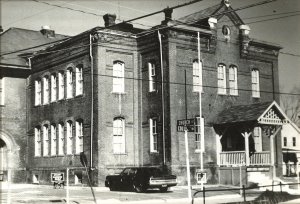 Enfield residents wanted the new college to be named “Greater Enfield CC”, and there was precedent because at the time, Capital was named Greater Hartford However, that name never was going to happen because Senator Charlie Alfano, President Pro Tem of the State Senate, lived in Suffield. He had put together the coalition that got the college funded. No way that he was going to allow that name!
Enfield residents wanted the new college to be named “Greater Enfield CC”, and there was precedent because at the time, Capital was named Greater Hartford However, that name never was going to happen because Senator Charlie Alfano, President Pro Tem of the State Senate, lived in Suffield. He had put together the coalition that got the college funded. No way that he was going to allow that name!
The college opened as North Central CC, which also had precedent at the time as Gateway was called South Central. However, President Dan McLaughlin and many employees as well as some folks in the community did not like that name. No character.
College faculty and staff were doing quite a bit with outdoors activities and Native American heritage. They created a community garden, an organic and natural foods co-op, courses like “Field Trip in Natural Science” and “Chemistry of Foods” – “Wilderness, Nature and the American Mind” and “The American Indian” – way before other colleges were introducing those subjects.
I believe it was the Regional Advisory Committee (it was thought important back then to have community input into local colleges) that worked with college staff on a new name. At the time there was a trend to use indigenous tribe names, such as Tunxis and Mohegan (now Three Rivers) – both established only 2 years prior to Asnuntuck.
With the precedent of naming colleges after indigenous tribes, the first suggestions fit that pattern. The local committee was making a presentation to a Board sub-committee. I had to bring some files to Dr. Charles, head of the system at the time, and heard the first name suggested.
Podunk CC.
They were discussing the history of the Podunks in this area. No one was saying the obvious, as they were focused entirely on the Native American connection. I finally went over to Dr. Charles and whispered in his ear to stop thinking about that connection, just use the word! He immediately turned to the Board Chair and whispered in his ear. Mr Fagan called for a recess. Whew!
A few minutes later I had to bring something else in to Dr. Charles. They were intently discussing the next name on the list, which had a good connection to the area since there is a state forest in Somers with the name.
Shinipsit.
I was young and it took me about 2 seconds to shorten the name, which I knew many others would. I again whispered in Dr. Charles’s ear to forget the Native American connection and just say the name fast 5 times. Again, he turned to Mr. Fagan, and again Mr. Fagan called for a recess.
This time Dr. Charles told me to stay in the room.
I didn’t have to whisper again, as the next name was Asnuntuck (means Freshwater), which seemed like a blessing to me as I recall getting stares from the committee bringing the names forward.
I’ve always thought I should have been rewarded by Asnuntuck employees and students so they didn’t have to say they worked at, or had taken courses from, Podunk CC, or Sh**sit CC. Unfortunately, no one ever thought they should fund my vacations.
Dan McLaughlin did thank me a couple of times, however.
Recollections of Bill Searle, September, 2022
Second Chance Pell – College For Inmates – 2016! Nope, at Asnuntuck in 1977!
Nearly 40 years before the rest of the country figured a way for prison inmates to get grants to go to college, Asnuntuck did it. The college had a large inmate education program, and funding was cut back. Who figured a way for inmates to get federal financial aid? Cal Mears, who ran the program.
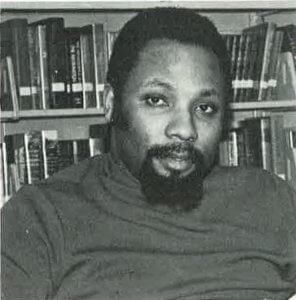 He had been hired in 1974 to bring order to the program, get more inmates involved, and get more inmates certificates and degrees.
He had been hired in 1974 to bring order to the program, get more inmates involved, and get more inmates certificates and degrees.
In two years he did exactly that. Enrollment doubled, retention went sky high, the first two inmates graduated in 1975. Even notoriously jaded Corrections Officers were impressed. When regular Correctional Officers speak highly of someone from the outside, AND inmates also like and respect the person – well, you get the picture.
With inmates he brooked no disrespect, no bad behavior. When Cal told them that they had to come talk to him, they came. Virtually every day he was at the two prisons, talking with inmates, advising, checking up. Also, CO’s quickly learned not to interfere with an inmate’s study time unnecessarily.
Studying? Well, if you got less than a “C” in a course, you were put on “Cal Probation” – not a good place to be. First, next semester you will take the course HE tells you to take. Second, you WILL show up for tutoring.
You see, Clarence Mears, Jr was well aware of what happened to all-too-many poor people once they got involved with the criminal justice system. Even worse if you were black. He knew that empathy, understanding, and toughness were the ingredients necessary to helping men change their lives.
Cal ran “voluntary” tutoring time regularly at both prisons. You were there to do homework, work COOPERATIVELY with another inmate or two, get some help. Emphasis on the word “work”. Oh, and that “voluntary” word – yeh, it was “voluntary” in the sense that if you didn’t come and work, then no more courses.
Cal’s interviews of prospective teachers became almost legendary. “Give Respect” – “Require Respect”. He rejected many applicants. Then he prepped the instructors! Make the course even a little harder – these guys have to be better than a regular student because they already have two+ strikes against them. Don’t break the rules. Be engaging. No pretend toughness, no pretend empathy.
Cal’s program also got the only American Bicentennial Award given to a program in Connecticut, and we were told the only one given to any community college. National Award. 1976. Two years after he got to Asnuntuck.
By the late 70’s it was clear that the program was working as the recidivism rate for people who completed at least a number of courses was far below the average.
Back to the federal financial aid. Recall how the CO’s respected Cal. The deal was when an inmate got a letter from the federal government with a check in it, the letter was given to Cal. He met with the inmate and the inmate made the check over to the college to pay for courses. It worked for several years until the feds decided it was not appropriate to give aid to inmates. For nearly 40 years.
Cal had a side job also. He was deputized by the staff to tell the young dean who thought he knew so much when he had done something unbrilliant. Cal would stand in the office door and speak … “Oh Sun God Most High, He Who Knows All, Solves All, Most Brilliant One.’’
“Here it comes. I’ve really screwed up when Cal uses all those words.” The dean* would steel himself. Cal knew the dean before Asnuntuck, was articulate, highly respected by the dean, and as a smart, tall, black man if he also bowed while saying “Sun God …”– well, it was really bad news because Cal did not bow to anyone. They’d both laugh, but Cal made sure the dean got the point!
Clarence Mears Jr helped a great many men change their lives, and as Deb Matusko, who worked with him for years, put it “…he was a really good guy, a good teacher himself, funny and understanding, very respected by faculty and staff, someone you could always count on.”
Cal Mears: An Asnuntuck Original.
Bill Searle, Fall 2022
*Truth be told, that young Dean “so sure of himself” was the author!
Singers and Bands at Asnuntuck

”Sonny Terry – THE SONNY TERRY and THE RICHIE HAVENS both played at Asnuntuck? You are kidding me!”
“Nope. Sonny Terry and Brownie McGee, Richie Havens, and many more played at Asnuntuck Community College in Enfield, Connecticut!”
Who got them? Paul Duval, a college counselor. “Paul wanted to build community at our new college, and get Asnuntuck known. What better way than to bring in bands and invite everyone! It was a great time,” said Bob Bergquist, Professor of Mass Communications (ret.).
“Yes,” agreed Elaine Folkers, Professor of Computer Science (ret.), “Paul had contacts in Northampton and convinced people to stop in Enfield on Thursday nights on their way north, or on Monday or Tuesday night on their way south. He did a lot to build community at ACC! Plus, we had students learning the equipment, and seeing new career opportunities.”
But, where? In ’74 the college moved to the Phoenix Avenue warehouse building. Lack of money to build rooms and a feeling among some that “open classrooms” might work in college led to a large open space in the building where 4 ‘class non-rooms’ were located. Making space to stand and dance was relatively easy. Everyone simply moved student desks and half-dividers to the outside walls.
Did it work? Hundreds of people came; students brought their friends. Not only was it an effective way of bringing students and staff together, the concerts put Asnuntuck on the radar, bringing in new students and leading many creative young people to see ACC as ‘the place to be’. Unfortunately, the Elm Street building had no such large space so the concerts ended when we moved.
Paul did other things to build community. Back then, counselors taught Soc 190, where he had students learn about various community service programs throughout the region, and become ambassadors of the college during their required community service hours. He also developed a course in The Holocaust, to expand students’ horizons. A significant benefit of teaching both courses was that Paul knew the challenges that faculty experienced teaching in the ‘open classroom’ area – which of course made faculty treat him as an equal. Another way to build community, both with students and with faculty.
Bands that appeared At Asnuntuck ca 1974-82
Roomful of Blues
Sonny Terry and Brownie McGee with Leroy Little
Albert Collins with A.C. Reed
Sunnyland Slim
Eddie Shaw and the Wolf Gang featuring Hubert Summerlin
Lonnie Brooks
Son Seals
Johnny Copeland (Shamika’s dad)
J B Hutto
Jeff Muldauer
Eddie Clearwater
Johnson Mountain Boys
Arwen Mountain String Band
Hazel Dickens
Carrie Bell
Sleepy LaBeouf
Fenton Robinson
Ko Ko Taylor
Cowboy Jazz
Rory Bloc
Richie Havens
George Gritzbach
Local acts that also appeared
Fat Clean Living Firewater
Bev Rouhler
And, Some of my best friends
*The open classroom experiment did not work at the college level!
Bill Searle Fall 2022
